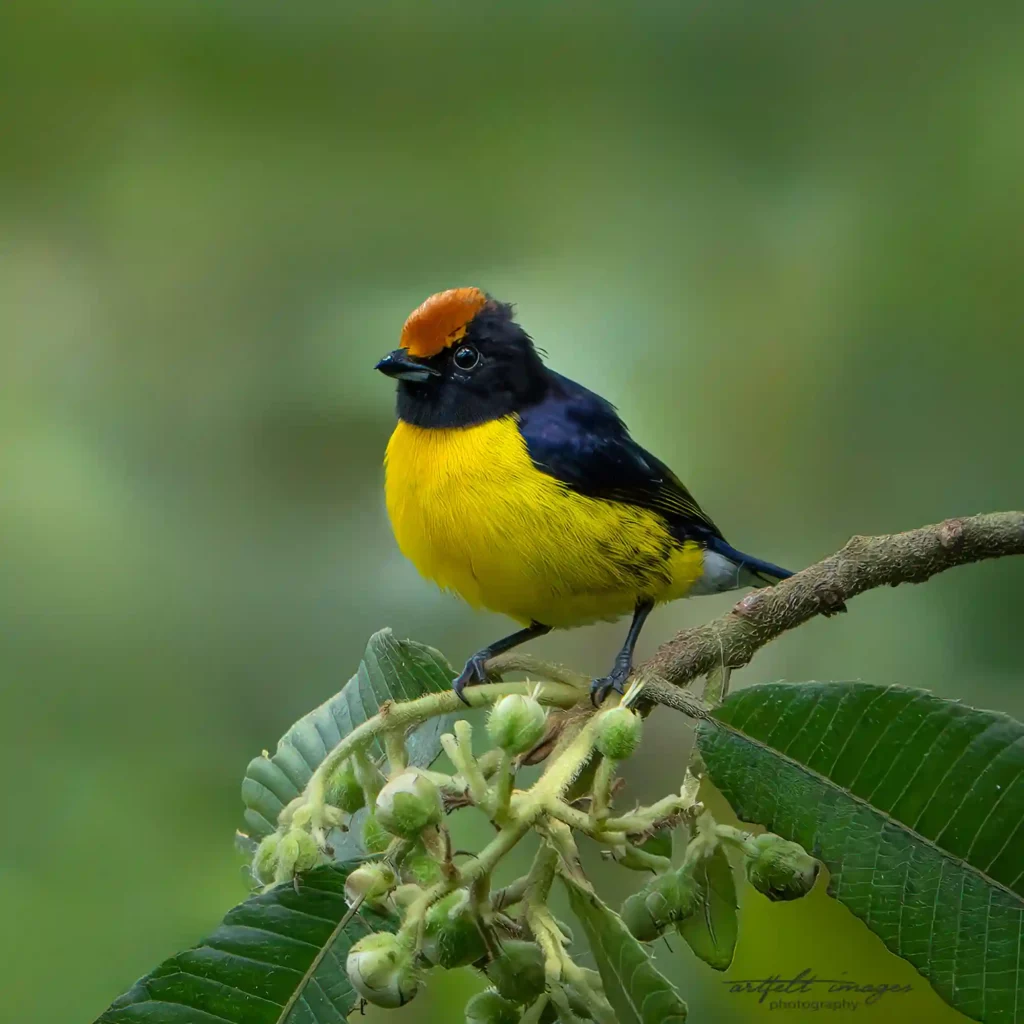Tawny-capped Euphonia
The Tawny-capped Euphonia is a vibrant, small songbird native to the humid forests of Central America. Renowned for its striking coloration and melodious calls, this species is a favorite among birdwatchers exploring the montane regions of Costa Rica.

Euphonia anneae
Scientific Name
Fringillidae (Finches)
Family
Passeriformes
Order
E. a. anneae
Subspecies. (found in Costa Rica and western Panama)
E. a. rufivertex
Subspecies. (found in central Panama to northwestern Colombia)
Range and Habitat of Tawny-capped Euphonia
Geographic Range
This species is found from the Caribbean slope of Costa Rica through Panama and slightly into northwestern Colombia .
Migratory Patterns
The Tawny-capped Euphonia is non-migratory, residing year-round within its range .
Preferred Habitat
Prefers canopy and edge of humid foothill forest adjacent to clearings and fruiting shrubs and bushes.
Altitude Range
Typically found between 300 and 2,000 meters above sea level.
Costa Rica Habitat
In Costa Rica, the Tawny-capped Euphonia is commonly observed in the Caribbean foothills and montane forests, particularly in areas rich in epiphytes .
Conservation Status
Least Concern
Conservation Status
Population Status
Currently classified as Least Concern by the IUCN, indicating a stable population across its range.
Habitat loss due to deforestation and human encroachment poses the most significant threat to the Tawny-capped Euphonia.
Conservation efforts
Conservation efforts focus on preserving natural habitats and protecting forested areas, which are crucial for the species' survival.
Primary Threats
Habitat loss due to deforestation and human encroachment poses the most significant threat to the Tawny-capped Euphonia.
Tawny-capped Euphonia Identification
How to Identify the Species
Rarity Level:
OccasionalBest Viewing Times:
Early Morning (Dawn - 8 AM), Evening (Dusk)
Size
Length: Approximately 11 cm (4.3 inches) Weight: Around 14.4–15.4 grams
Plumage
Males exhibit a tawny-orange crown, blackish-blue upperparts, and bright yellow underparts. Females are olive-green above with a duller yellow below and a rufous crown.
Distinctive Features
Short, stout bill adapted for fruit consumption; vibrant coloration in males; subtle hues in females.
Sexual Dimorphism
Males and females have distinct plumage, with males displaying more vivid colors compared to the more subdued tones of females.
Diet and Feeding Behavior
Primary Diet
- Primarily frugivorous, feeding on small berries, including mistletoe berries and figs.
Foraging Techniques
- Forages in the forest canopy and edges, often seen in pairs or small groups.
Feeding Times
- Active during daylight hours, with peak feeding activity in the morning and late afternoon.
Behavior Patterns
Tawny-capped Euphonia
Social Structure
Typically observed alone or in pairs; not known to form large groups.
Song and Vocalization
Emits a series of high-pitched, melodious notes; vocalizations are more prominent during the breeding season.
Courtship and Mating Ritual
Males may perform displays and vocalizations to attract females; both sexes participate in nest building.
Territoriality
- Territorial during the breeding season, with pairs defending nesting sites from intruders.
Birdwatching Tips
Best Locations for Spotting Tawny-capped Euphonia
In Costa Rica, prime locations include the Caribbean foothills and montane forests, particularly areas rich in epiphytes.

Best Time of the Year
Year-round, with increased visibility during the dry season (December to April).
Common Behavior
Look for individuals flitting through the forest canopies, especially during early morning hours.
Recommended Gear
Binoculars with good resolution, a camera with a zoom lens, and a field guide for identification.
Breeding and Nesting Behavior
Breeding Season
In Costa Rica, breeding activity is observed year-round but is most common during the dry-to-early wet season, often tied to fruit availability in mid-elevation forests.
Nesting Sites
The pair builds a domed nest with a side entrance, typically hidden in mossy tree branches, vines, or epiphytes, about 1.5 to 4 meters above the ground. Nests are carefully camouflaged using plant fibers, moss, and lichens.
Clutch Size
Typically three to five eggs per nest. Eggs are whitish or cream-colored and may have light speckling
Incubation Period
Only the female incubates, for about 14–15 days. During this time, the male often remains nearby and may assist with feeding after hatching.
Parental Care
Both parents feed the chicks with regurgitated fruit, especially mistletoe berries and figs. Nest visits are brief and infrequent, likely to reduce predation risk. Chicks fledge approximately 19 days after hatching.
Did You Know?
Frugivorous specialists
Tawny-capped Euphonias feed primarily on soft fruits and berries, especially mistletoe. Unlike most birds, they lack a true gizzard—an adaptation to their fruit-rich diet.
Male and female look alike
While many euphonias show sexual dimorphism, this species is notable for both sexes having similar plumage—bright yellow underparts and a rich tawny cap
Quiet but social
Though not particularly vocal, they communicate with high-pitched “seee” notes and are often seen in small flocks or mixed-species groups.